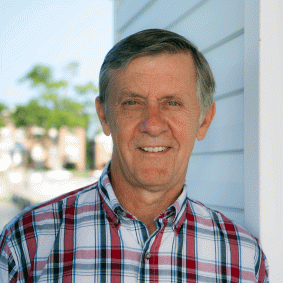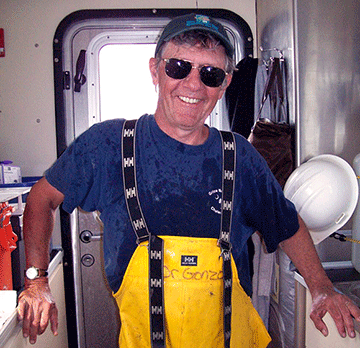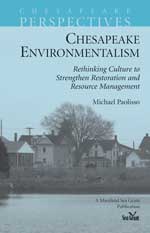Knauss legislative fellowships in Congress help build careers — and they're fun and educational. See our video and fact sheet for details.
Maryland Ecologist Walter Boynton to Receive Mathias Medal

Walter Boynton, whose groundbreaking research helped establish that excess nutrients degraded the Chesapeake Bay’s water quality and habitats, has been chosen to receive the Mathias Medal to recognize his distinguished career of scholarship and public service.
The medal is awarded jointly by Maryland Sea Grant, Virginia Sea Grant, and the Chesapeake Research Consortium and is named for the late U.S. Senator Charles “Mac” Mathias of Maryland, who championed efforts to clean up the Bay. The award recognizes outstanding scientific research that contributes to informed environmental policy in the Chesapeake Bay region. Since the Mathias Medal was established in 1990, only six have been awarded.
Boynton was hailed by the Mathias Medal selection board for his wide-ranging and foundational research, which has offered new insights into how the Bay’s ecosystem works. Some of these research concepts initially drew controversy, but are now broadly accepted. Starting as a research assistant in 1969, Boynton spent his career as an estuarine ecologist at the Chesapeake Biological Laboratory, a part of the University of Maryland Center for Environmental Science (UMCES).
Among his many accomplishments was co-authoring one of the first scientific papers, still widely cited, that implicated excess nitrogen washing into the Chesapeake from farms, parking lots, and other human sources as a key driver of the eutrophication process, which has damaged the Bay and other estuarine ecosystems worldwide. In eutrophied systems, excess nitrogen fuels blooms of algae; when these die and decompose, they contribute to the creation of low-oxygen “dead zones” that impair the ecosystem. In the Bay, vast swaths of native sea grasses have died out and fish populations have been stressed because of excess nitrogen, phosphorus, and sediments.
Boynton’s research has formed a critical part of the foundation of scientific knowledge that continues to inform efforts to improve the Bay’s ecosystem. He and a variety of collaborators worked persistently for years to persuade natural resource managers and policy makers to monitor nutrients in the Bay and to take bold actions to reduce nutrient loads. Eventually leaders responded with a series of management plans now credited with lowering amounts of nutrients in parts of the Chesapeake’s vast watershed. Boynton helped to design the Chesapeake Bay Program’s monitoring effort, which began in 1984, is still operating, and is considered one of the best in the world.
Boynton and his laboratory colleagues have long referred to themselves as “The Gonzo Group” in homage to the outlandish characters and events described in author Hunter S. Thompson’s books and to Thompson’s penchant for participating in the events he wrote about. In that spirit, says the group’s laboratory webpage, the group has immersed itself in research and public outreach, and the Gonzo moniker “brings a smile to our sometimes stressed faces.”
As a member of the Mathias Medal selection board put it, “The implications of Dr. Boynton’s career and efforts to translate his (and others’) scientific discoveries to influence policy, protect the Bay, and influence our country are outstanding. He has influenced the Chesapeake Bay, our nation, and the world with his efforts.” Board members also applauded his work as a mentor for students and especially his efforts to educate the public about coastal science.
Boynton is known for his lively, friendly public speaking style that puts in simple terms both scientific concepts and the need to continue efforts to preserve the Bay. He honed that skill for years as he and his scientific colleagues worked to assemble enough research findings and monitoring data to persuade decision makers that the Bay was in trouble. In a 2002 interview, Boynton recalled that “people would ask, ‘Is the Bay really worse? Are grasses really down? How do we know?’ We were twenty years dumber then.”
Earlier in his career, many decision makers thought that “the only problem was point sources” such as industry and waste treatment plants that released nitrogen, Boynton recalled. Over time, his and other studies documented that nutrient loading from a range of geographically distributed sources (“non-point” sources) was causing declines in water quality. Still, a debate raged over whether nitrogen or phosphorus lay at the root of those declines. Boynton and his colleagues, whose work he has consistently praised for enabling his success, presented evidence that monitoring and reducing both kinds of nutrients was vital to the Bay’s future.
Boynton’s pioneering research about the Bay’s ecosystem dynamics has also provided new understanding of the causes and ecological consequences of the declining acreage of seagrass covering the estuary’s bottom. In addition, his research on the decline of the Bay’s striped bass population contributed to the adoption of a fishing moratorium, which helped the population to rebound.
More recently, Boynton published findings detailing how long-term management practices to reduce nutrients can lead directly to improvements in Chesapeake Bay ecosystems, as measured by higher abundance of seagrasses, clearer water, and smaller blooms of algae.
 |
| Walter Boynton. Photo: Eva Bailey |
His long list of influential public speaking and public engagement projects includes advising members of Congress, Maryland’s legislature, and local officials. He regularly briefed the Calvert County Commission about trends in water quality around Solomons, Maryland, and he applied his knowledge as an ecologist while serving for 11 years on the county’s Board of Appeals for zoning. He also spoke with citizens’ groups, school teachers, college audiences, and journalists.
Boynton will retire in June 2017 and now works 60-percent time at Chesapeake Biological Laboratory. His full C.V., listing his many papers, honors, and public service, is online here.
Photo, top left: Walter Boynton. Credit: Cheryl Nemazie
Maryland Sea Grant (www.mdsg.umd.edu) and Virginia Sea Grant (vaseagrant.org) are part of a state-federal partnership; our two programs work to develop and apply science to protect and restore the Chesapeake Bay and the coastal and marine resources of our respective states. We promote a sustainable, resilient coastal economy. The Chesapeake Research Consortium (ww w.chesapeake.org) is a nonprofit association of six institutions that support research and education on problems affecting the Chesapeake Bay and other regions. The consortium works to assemble multi-disciplinary scientific expertise to advance scientific understanding and foster improved science-based management of estuarine systems and watersheds across the region and throughout the world.
Learn more about the Mathias Medal.
Videos
This video, filmed and edited by Maryland Sea Grant video producer W. Michael Fincham, features interviews with Dr. Boynton and former Maryland State Senator Bernie Fowler about Walt's career. A shorter version of this video was played during the Mathias Medal award ceremony in Annapolis in December 2016.




